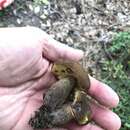en
names in breadcrumbs


Phlebopus is a genus of fungi in the family Boletinellaceae (suborder Sclerodermatineae of the Boletales order).[2] The genus has a widespread distribution in subtropical and pantropical regions, and contains 12 species. The species are saprobic, with some possibly able to form mycorrhizae with exotic trees in certain conditions.[3] It contains the gigantic Phlebopus marginatus, the cap of which can reach 1 m (3.3 ft) in diameter.[4]
The genus was originally described as a subgenus of Boletus by Roger Heim in 1936,[5] and raised to generic status by Rolf Singer that year.[6] It was later redescribed with another type species (Phaeogyroporus braunii) under the name Phaeogyroporus by Rolf Singer in 1944.[7] This name was used until 1981, when a specimen of Phlebopus colossus was collected and mycologist Paul Heinemann designated it as the lectotype.[8]
The genus name is derived from the Greek Φλεβο- "vein" and πους "foot".[9]
Phlebopus is similar in appearance to species in the genus Gyrodon, but distinguished by its olive-brown to brown spore print, its stem which is never hollow, and its smooth spores which are brownish when viewed with a light microscope.[8]
Phlebopus tropicus has been shown to form a crust of mycelium around the roots of species of Citrus in Brazil, covering colonies of the comstock mealybug Pseudococcus comstocki which attack the roots of these plants after they have been carried there by ants (Solenopsis saevissima var. moelleri); these mycelial crusts are called "criptas" by Brazilian writers. The Pseudococcus living in symbiosis with the fungus is believed to be the immediate reason for the subsequent death of the affected trees, but the action of an endotrophic mycorrhizal fungus weakens the plant before the attack of the Pseudococcus takes place.[8]
Phlebopus portentosus and P. spongiosus are popular edible mushrooms in the cuisine of northern Thailand. They can produce fruiting bodies without a host plant, and can be therefore cultivated.[10][11][12] P. bruchii is consumed as an edible mushroom in Argentina.[13]
Phlebopus is a genus of fungi in the family Boletinellaceae (suborder Sclerodermatineae of the Boletales order). The genus has a widespread distribution in subtropical and pantropical regions, and contains 12 species. The species are saprobic, with some possibly able to form mycorrhizae with exotic trees in certain conditions. It contains the gigantic Phlebopus marginatus, the cap of which can reach 1 m (3.3 ft) in diameter.
Phlebopus es un género de hongos de la familia Boletinellaceae (suborden Sclerodermatineae del orden Boletales).[2] El género tiene una amplia distribución en las regiones subtropical y pantropical, y contiene 12 especies. Las especies son saprofitas, con algunas posiblemente capaces de formar micorrizas con árboles exóticos en ciertas condiciones.[3] Contiene el gigantesco Phlebopus marginatus, cuyo sombrero puede alcanzar 1 m de diámetro.[4]
El género fue descrito originalmente como un subgénero de Boletus por Roger Heim en 1936[5] y elevado a estado genérico por Rolf Singer ese año.[6] Posteriormente fue redescrita con otra especie tipo (Phaeogyroporus braunii) bajo el nombre de Phaeogyroporus por Rolf Singer en 1944.[7] Este nombre se usó hasta 1981, cuando se recolectó un espécimen de Phlebopus colossus y el micólogo Paul Heinemann lo designó como el lectotipo.[8]
El nombre del género se deriva del griego Φλεβο- "vena" y πους "pie".[9]
Phlebopus es similar en apariencia a las especies del género Gyrodon, pero se distingue por sus esporas de color marrón oliva a marrón, su tallo que nunca es hueco y sus esporas lisas que son parduscas cuando se observan con un microscopio óptico.[8]
Se ha demostrado que Phlebopus tropicus forma una corteza de micelio alrededor de las raíces de las especies de Citrusen Brasil que cubre colonias del piojo harinoso común Pseudococcus comstocki que atacan las raíces de estas plantas después de haber sido transportadas por las hormigas (Solenopsis saevissima var. moelleri); estos crustáceos miceliales son llamados criptas por los escritores brasileños. Se cree que el Pseudococcus que vive en simbiosis con el hongo es la causa inmediata de la muerte posterior de los árboles afectados, pero la acción de un hongo endotrófico de micorrizas debilita la planta antes de que tenga lugar el ataque del Pseudococcus.[8]
Phlebopus portentosus es un comestible popular en la cocina del norte de Tailandia.[10] P. bruchii se consume en Argentina.[11]
Phlebopus es un género de hongos de la familia Boletinellaceae (suborden Sclerodermatineae del orden Boletales). El género tiene una amplia distribución en las regiones subtropical y pantropical, y contiene 12 especies. Las especies son saprofitas, con algunas posiblemente capaces de formar micorrizas con árboles exóticos en ciertas condiciones. Contiene el gigantesco Phlebopus marginatus, cuyo sombrero puede alcanzar 1 m de diámetro.
Phlebopus is een geslacht van schimmels behorend tot de familie Boletinellaceae.
Het geslacht Phlebopus bevat volgens de Index Fungorum de volgende veertien soorten:
Phlebopus is een geslacht van schimmels behorend tot de familie Boletinellaceae.